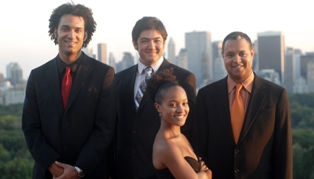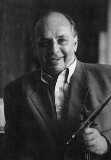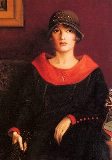The Harlem Quartet brought more than diversity to the
University of Cincinnati College-Conservatory of Music’s Robert Werner Hall Tuesday
evening (Dec. 7).

Presented by Chamber Music Cincinnati, they brought youth, energy, excellence, excitement and a wide range of repertoire. Everything from A to Z, in fact, with music by Alexander Borodin and Judith Lang Zaimont, among others.
Their program was generous and thoroughly rewarding, with four string quartets and “Take the ‘A’ Train” by Billy Strayhorn. Best of all, the concert offered a look at what chamber music is and can be, and how the art form continues to refresh itself.
The Harlem Quartet was founded in 2006 by the Sphinx Organization, a non-profit arts and youth development organization devoted to helping overcome the cultural stereotype of classical music and encouraging the participation of blacks and Latinos. The original members of the Quartet, violinists Ilmar Gavrilan and Melissa White, violist Juan-Miguel Hernandez and cellist Desmond Neysmith, all were winners of the annual Sphinx Competition. With the departure of Neysmith, cellist Paul Wiancko, an international prize-winner in his own right, was invited to join the ensemble this fall. (Wiancko, of Japanese-Polish heritage, makes the Quartet even more diverse.)
The ease and joy with which the four musicians
communicated and played were remarkable. Fittingly, the event
marked the second annual Henry W. Meyer Concert, named for the late CCM
professor and LaSalle Quartet violinist in honor of his dedication to teaching.

The concert opened with Beethoven’s Op. 18, No. 3, a classical quartet with strong linkage to Mozart and Haydn. First violinist Gavrilan (a native of Cuba, who studied at the Moscow Conservatory) spun its long opening phrase with grace and refinement. The slow movement was sublime, with every detail given just the right amount of emphasis. The finale (Presto) took off at a clip, again with a shapely lead by Gavrilan, who tapered the opening theme with finesse. The precision and ensemble of the group were exceptional, indicating that they were of one mind throughout.
American composer Zaimont’s quartet “The Figure,” commissioned for the Harlem Quartet in 2007, brought the audience into the 21st-century. Its two movements are entitled “In Shadow” and “In Bright Light.” “In Shadow” began almost metaphorically, with harmonies resolving to different pitches simultaneously for a dark, uncertain effect. Sonorities were full, rich and atonal, with many stops and starts, giving it an episodic feeling. There was snap pizzicato and at one point, loud stamping of feet. Gavrilan ended in the violin’s highest register.
“Into the Light” proceeded from effects like subito piano (suddenly soft), rapid, swept bowing and stinging attacks, to a more amiable, major-mode passage with the melody in the first violin. The music steadily grew consonant, with triadic harmonies and soft harmonics at the end.
The Harlem Quartet plans to record “The Figure” and other works by Zaimont on a Parma/Navona CD to be released in April. Collaborating with them will be CCM pianist Awadagin Pratt.
Gavrilan recounted the story of how “Take the ‘A’ Train” got its name (it was the first thing that came to Strayhorn’s mind when Duke Ellington asked him for a title). Then it was on to a new stylistic destination, jazz. Hernandez (Canadian-born of Dominican heritage) led off with the beat, and each player stood up for an improvised chorus (except cellist Wiancko, of course).
After intermission, there was another switch, and what a surprise after jamming with Strayhorn. The players were in full late Romantic mode in Borodin’s Quartet No 2, each providing precise tonal definition to create a rapturous effect.
Borodin’s Second Quartet is “Kismet” territory, and the songs “Baubles, Bangles and Beads” and “This is My Beloved” were appropriated from the second and third movements (Scherzo and Notturno) of the quartet for the 1950s Broadway musical. Gavrilan shared gorgeous exchanges with Wiancko and White in the “Notturno,” which Borodin supposedly wrote as a love song for his wife.
Highlight of the concert was three movements from
Wynton Marsalis’ String Quartet No. 1, “At the Octoroon Balls.” (Historically, these were dances where Creole
men could meet and select mistresses from mixed race women, “octoroons” being
one-eighth black.)

Each movement was introduced by one of the players. “Rampart Street Row House Rag” is about “a house of ill repute,” said Gavrilan. “Mating Calls and Delta Rhythms” conjures love in the Delta, said Hernandez, who demonstrated a few hopeful bird calls and ogled White. Translate “Hellbound Highball” as the train to you-know-where, that makes no stops along the way, they said, demonstrating with screeching rails (Gavrilan’s bow) and the Doppler Effect (Wiancko sliding backward on the strings).
Accordingly, “Rampart Street Rag” pulsed with ardor. The torpor of “Mating Calls and Delta Rhythms” was broken at the end by a big unison pizzicato. “Hellbound Highball” rumbled and sped fiendishly ahead, almost stopping once or twice, White signaling to get off (high pizzicato), only to have it lurch forward again.
Hell had to be paid, however, and the quartet exited the stage still playing their instruments, this time with Wiancko holding it aloft and bowing all the way.
Marsalis has outdone himself in “At the Octoroon Balls,” which fearlessly bursts the boundaries of the string quartet form as we have known it. It would be good to hear a complete performance of the work.